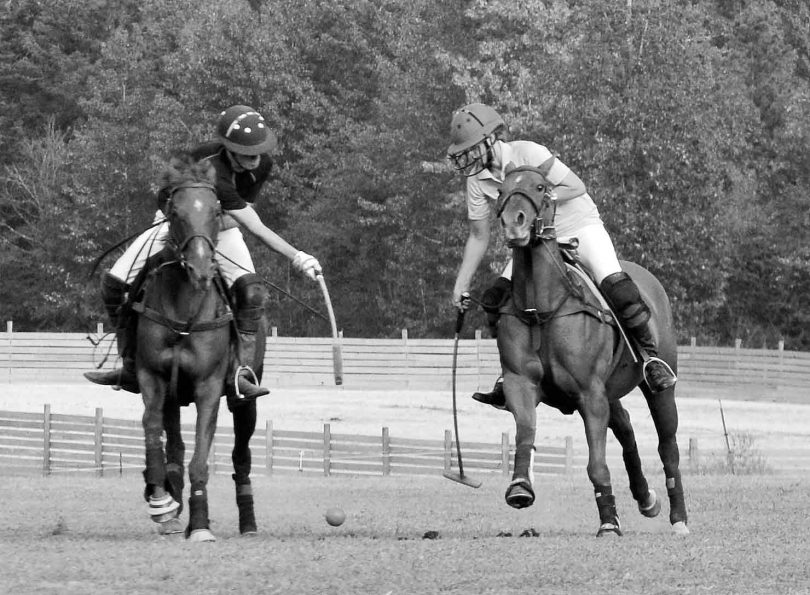Caroline Gilmore
Humans have hunted horses across the Eurasian steppe for at least 100,000 years. Based on an analysis of bones found at two sites, scientists estimate that horses were first domesticated on the plains of Kazakhstan roughly 5,500 years ago by people who rode them and drank their milk. Current-day use of horses still ranges from food source to basic transport to sophisticated competitions.
Polo may not first come to mind when one thinks of horses in North Carolina. Fifth-generation horseperson, David Brooks founded Triangle Area Polo Club (TAPC), the only polo club in NC in 2011. He purchased an 85-acre farm and transformed it into a family-operated, full-fledged U.S. Polo Association member club which houses 14 polo ponies in the lesson program. Brooks runs Crooked Creek Farm, the home of TAPC full time, along with help from his wife, Leslie, and two teenage sons.
Located NW of Durham in Hurdle Mills, the farm provides an ideal atmosphere for those who want to learn about polo. The majority of students hail from the Chapel Hill/ Carrboro area and also from Durham, Hillsborough, Raleigh and Greensboro, but some come from as far as Hickory and even New York state. Brooks’ students range in age from 9 years to over 65 years; several students are in their 60s.
“We get a lot of people who come out who rode as kids or young adults. A lot of them are coming back to it now that they have the time and the kids are gone,” Brooks told CSN. He added that the “system is set up for everyone to come in and learn to play. I teach at every level.” He heartily believes in youth development, even becoming a Certified Polo Instructor and uses his skills to teach lessons year round, to coach interscholastic (grades 5 through 12) and intercollegiate polo teams that complete in tournaments and to offer summer camps.
Most of the kids in the lesson program are high school-aged, but there are some kids from junior high school, too. In the fall of each year, the high school kids go to Charlottesville and Baltimore to play in polo tournaments.
I went to a polo match with tailgating at the farm on a beautiful Saturday afternoon in September. It seemed to be a festive affair, with many cars parked along the sidelines of the polo field. The Cary Debutante Ball Society was holding an event at the match, so the scene was complete with candelabras, white tablecloths and delicate finger food. But there were groups and pairs of young people and old people and families, some with small children, all watching the polo match with interest and enthusiasm.
The two polo teams, which typically consist of four players each, played one polo match which consisted of six 7.5-minute periods or chukkers. There are breaks between chukkers and at halftime, so a typical polo match lasts about 1.5 hours.
The polo ball measures approximately three inches in diameter and is thrown or rolled into play by the umpire at the start of the game. Then both teams use mallets to try to hit the ball through the opposing team’s 24-foot-wide goal to score a point. The polo field is usually 300 yards long and 160 yards wide and is the largest field for an organized sport. During halftime, spectators go onto the field to participate in a tradition called “divot stomping” to help replace the divots created by the horses’ hooves.
The polo action was fast-paced in bursts intermingled with repositioning players and horses to set up for the next play. I kept my eye on the red polo ball to follow the play. I couldn’t imagine being on top of horse and trying to hit the ball, all the while controlling myself and the horse, let alone having to worry about what other players and other horses are doing around me!
While I was watching the match, I met a man and woman from Mebane who were starting polo lessons the next week. He was 65 years old and had only a little horseback-riding experience. I learned that the youngest player on the field was 12-year-old Brayden Foster who has been playing polo for four years.
Jordan Lee, 26 of Hillsborough, has only been playing polo for six months. She told CSN “Playing is a blast…and it’s addicting… To me, it’s the ultimate accumulation of all things wonderful.”
To get started in polo, prospective students undergo an assessment lesson to determine where they are with their riding experience. Brooks holds individual and group lessons five days a week and uses an Earn Your Mallet approach in which beginners learn riding basics before they start using mallets. Once beginner students have learned to ride adequately, they can join the students in one of the experienced rider groups.
For this group, Brooks runs skills and drills nights during which students specifically work on riding skills, hitting skills, stopping and turning and changing speed. There are 12 basic shots to learn in polo as well as the game rules and tactics.
Brooks characterizes polo as a competitive, outdoors, athletic team sport and that “it’s a little bit different from what’s out there.” But, he added that the polo world has to fight the stigma of only being for the rich. He summarized, “If you can afford to play golf or tennis, you can afford to play polo.”
“The biggest thing to know about polo is that we’re here and it’s for everyone. It’s not just for the rich and famous.” And, he added that sitting on the sidelines during a match is another way to be involved with and supportive of polo.


